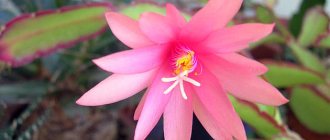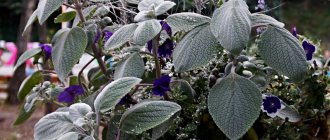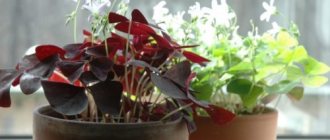The plant, which is popularly known as Decembrist or Rozhdestvennik, is scientifically called epiphyllum, zygocactus and schlumbergera. It represents the Cactus family. I fell in love with the flower primarily because its peak bloom occurs during the New Year holidays.
Many are surprised when they find out that the Decembrist refers to cacti. People are accustomed to meaning by this word something prickly, afraid of waterlogging and loving good lighting.
Decembrist belongs to the Cactus family
But this plant destroys existing stereotypes and captivates with its beauty.
general information
In fact, Decembrist or Schlumbergera is an epiphytic cactus native to the Brazilian tropics. It grows on other trees and stores moisture and nutrients abundantly in its segmented stems. Another name for Decembrist is zygocactus.
Unlike many epiphytes, Decembrist is not a parasite. He simply clings to trees and hides in their shade, but gets his own food. The average length of the shoots is about 40 cm, and they consist of flat, jagged or rounded links. New segments gradually grow from existing segments, and in winter buds appear at the tips of the stems.
Pink and red Decembrists are most often found, but breeders have already managed to develop a greater variety of shades. The flowers are multi-tiered, bizarre funnel-shaped, up to 8 cm and up to 30 petals each.
Photo: mandarin-shop.ru
Description of zygocactus
It differs from the classic types of cactus, has no spines, and naturally lives in the forests of Brazil among tree trunks and on stumps. A distinctive feature of the zygocactus flower is the flat segments that make up the plant. They are most often pointed along the edge, although modern varieties with a rounded edge are also found. The plant is epiphytic; the root system is weak, which is important to consider when choosing soil and containers for planting.
It usually blooms profusely. The peculiarity of the flowers is that they have petals in several tiers. This distinguishes Decembrist from its relative Ripsalidopsis. The color of the buds is white, pink, crimson.
Types of the Decembrist
Most often, two specific types of Schlumbergera are called Decembrist. Truncated or chopped off - more compact, with light green shoots up to 40 cm. There are different shades of pink, purple and white. Schlumbergera Buckley or Bouclea is larger, up to 50 cm, and its shoots are darker. This is an ampelous look. Of the hybrid varieties, Lavender Doll, Windsor, Christmas Fantasy, Pasadena and Santa Cruz are especially interesting.
Photo: sueveriya.com
Hamedorea (50 photos): types, cultivation and care at home
Common mistakes beginners make when growing
Many difficulties can be avoided if you properly organize the care of your Christmas cactus. When creating a microclimate, it is necessary to take into account the characteristics of the plant and the season. Beginners often do not know or ignore recommendations for caring for the Decembrist. Caring for an exotic flower, although not difficult, requires attention to detail.
Common mistakes:
- too rare or frequent watering;
- the use of hard water for irrigation, as evidenced by a white coating on the soil and walls of the pot;
- excess fertilizer, leading to discoloration and curvature of leaves;
- insufficient air humidification, stimulating the active formation of aerial roots;
- unfavorable room temperature.
Caring for the Decembrist
Decembrist is not at all demanding, but still, for lush and abundant flowering, you need to follow several recommendations. This is especially true for temperature and lighting.
Temperature
To form buds, you need a temperature from 7 to 16 degrees. After this, optimal conditions are around 20-24 degrees during the day. At night, the temperature can be lowered again to 16, but not less. The frost resistance limit of most varieties is 2 degrees.
Photo: pocvetam.ru
Lighting
Decembrist requires bright, diffused light for 8-12 hours a day. At the same time, during the formation of buds, the length of daylight hours is especially important. The rest of the time the plant feels good in partial shade. Periodically, it can be deployed so that the Decembrist bushes evenly, but not during flowering.
Photo: pl.besthomemaster.com
Watering
Between waterings, the earthen ball should partially dry out. Remember that Decembrist is a cactus, so it is better to underfill it than to overfill it. Excess water is the most common cause of plant death. And always drain the remaining liquid from the pan.
Photo: oir.mobi
The soil
Unlike many other cacti, the abundantly flowering Decembrist prefers nutritious soil. A loose mixture based on leaf soil and humus is suitable. Be sure to add sand, perlite or stone chips. Crushed coal and bone meal will not be superfluous.
Photo: waysi.ru
Fertilizers and fertilizing
Once a month, Decembrist can be fed with complex mixtures for cacti or succulents. But use small concentrations, half the recommended concentration. It is convenient to take liquid fertilizers for watering, but make sure that they do not get on the shoots.
Photo: babushkinadacha.ru
Trimming
In order for the Decembrist bush to grow more lush and voluminous, it must be periodically trimmed. This must be done carefully between the plates, and then each such shoot will give up to 5 branches. Pruning is done after flowering.
Photo: o-flora.com
Transfer
Decembrist is replanted once a year in summer or autumn, partially pruning the shoots along the way. You should not take a pot that is too large, because instead of flowering, the plant will begin to grow roots and shoots. Pots are suitable low and wide.
Photo: kaktus-sukkulent.ru
Date palm (50 photos): types, care and cultivation at home
Reproduction
Lady's slipper: popular types and conditions for flower care
The Christmas flower has such magical beauty that you want to place pots of it throughout the house, as well as give such a flower to relatives and friends. To do this, you should know how this plant propagates correctly. Some gardeners combine this procedure with pruning.
Cuttings
Cuttings are a simple and reliable way to propagate Decembrist. In order for the work done to be successful, a certain sequence of actions must be followed:
- making circular movements, separate a part of the stem with three segments from the plant;
- leave the prepared cuttings in natural light and room temperature for three days to dry;
- pour soil mixture for cacti and succulents into small cups;
- deepen the cuttings into cups with soil mixture;
- cover the vessel with a glass jar or plastic bag to create greenhouse conditions;
- Place the seedlings in a shaded room with a temperature of about +20°C for 1 month, water the soil daily and organize ventilation of the greenhouse.
Cuttings are the simplest and most reliable way to propagate Decembrist
Graft
Not everyone knows that there is another way to get a new Decembrist on your windowsill - grafting. It is used extremely rarely, since this technique is not only labor intensive, but also has various nuances. If you want to experiment, you can propagate the flower by planting a shoot to the prickly pear.
The Decembrist reproduces extremely rarely by grafting
The prickly pear stem is carefully split, then a pointed shoot is inserted into the crevice. The connection point is fixed with a needle, then additionally wrapped with tape or tape. After a couple of weeks, the Decembrist should grow together with the mother plant.
Decembrist has been grown as a houseplant for a long time, but it has become especially popular in recent years. Flower growers attribute this to the fact that new interesting varieties have begun to be developed. Caring for the plant is not difficult; even beginners can easily cope with this task. The tradition of giving blooming Decembrist flowers for the New Year holidays is being revived. If necessary, you can easily propagate the flower yourself and share its beauty with friends and acquaintances.
Pest and disease control
Most often, the Decembrist suffers from a fungus - pythium or late blight, which affects the root collar. The shoots begin to die and fall off. The most common causes are contaminated soil or overwatering. In this case, immediate treatment with fungicides is necessary.
There are other types of fungus, but the principle of treatment remains the same. It is necessary to carefully remove the affected segments and spray the plant with medicinal preparations. But keep in mind that if the damage is severe, this may no longer help, so inspect the flowerpots regularly.
Decembrist is loved by spider mites, scale insects and mealybugs. First you need to carefully wipe the shoot segments with soapy water, and then treat them with insecticides. If there are few pests, a strong onion or garlic infusion will do.
Photo: greensotka.ru
Hatiora (50 photos): types, care and cultivation at home
Peculiarities
The main advantage of this unusual cactus is its ability to bloom all year round. But you will need to carry out care measures. Problems may also arise due to the need to change temperature and humidity.
Zygocactus flower: home care
But if you take into account a few additional tips, all the disadvantages can be minimized:
- You should not place the cactus on a western or southern windowsill. These areas usually have the brightest lighting.
- In summer, the plant should be well ventilated. But you need to avoid places where fungi from other plants (for example, those that neighbors have or in the yard) can reach the cactus.
- If the humidity is low, then you can periodically put the zygocactus in the shower.
If you follow all the recommendations, the zygocactus will delight you with numerous flowers. At home, it can live for several decades. And if you graft it onto another plant, it will become much more magnificent. The main thing is to monitor soil moisture and the frequency of watering and fertilizing.
Decembrist – photo
Decembrist was loved for its lush flowering, which is almost impossible to spoil. This plant is suitable even for beginners and will delightfully decorate any interior!
Photo: flower care.rf
Photo: waysi.ru
Photo: sueveriya.com
Photo: zen.yandex.ru
Photo: evrookna-mos.ru
Photo: photocentra.ru
Photo: myplantin.com
Photo: ay.by
Photo: sharkpool.ru
Photo: oir.mobi
Photo: waysi.ru
Photo: greensotka.ru
Photo: oir.mobi
Photo: waysi.ru
Photo: ofigeno.ru
Photo: sadovnikam.ru
Photo: zen.yandex.ru
Photo: evrookna-mos.ru
Photo: flower care.rf
Photo: klubrasteniy.ru
Did you like the post? Subscribe to our channel in Yandex.Zen, it really helps us in our development!
Bloom
Problems with flowering are associated with improper organization of the dormant period. Bud formation begins when daylight hours decrease, from September to November. It is important to lower the temperature to 13-18 degrees before flowering begins. Watering is also reduced at this time.
The plant needs to find a permanent place and not move it, otherwise Schlumbergera will drop its buds.
Active growth occurs from May to August; it is recommended to bring Decembrist to the balcony or garden.
Varieties
The names of Schlumbergera varieties reflect both the origin and decorative characteristics of the plant. There are a lot of varieties, their description concerns more the differences in color and shape of the petals. The stem links may differ in size and, less commonly, in shape and color.
"Golden Fever"
It took many years of breeding work to develop yellow Schlumbergera varieties. Decembrist "Golden Fever" (or "Gold Rush") is famous for its multi-tiered large velvety flowers. Rich yellow shades of petals with a soft crimson center and bright green leaves give the plant a special zest.
"Malissa"
A very compact variety with surprisingly delicate colors: snow-white large flowers have a long pink pistil and delicate yellow stamens. Pleases with long flowering (up to four months).
"Dark Eve"
The white-pink, not very large flowers of this variety resemble bright tropical birds that momentarily landed on the green stems. Very cute, elegant and beautiful variety. Blooms generously and for a long time.
"Beach Dancer"
Charming, very delicate flowers of peach and pink shades with an orange border have rounded curved edges and therefore appear larger. The stems are long and drooping. A rather rare variety with unusual colors - a real find for lovers.
"Samba Brazil"
One of the most famous and unusual varieties. By crossing bright pink and snow-white zygocacti, scientists expected that the main color of the petals would be pink, turning closer to the middle into pearl. It turned out the other way around, but no less beautiful: the smoky petals are framed with a crimson edging. Samba brasil combines elegance and brightness in an amazing way.
"Kris Kringle"
This variety is distinguished by its compact crown and bright red inflorescences with a light stripe in the center of each petal. The stem segments are short, glossy, rich green in color, and very durable. The buds of one of the varieties of the variety - Kris Kringle II - are painted in orange tones.
Differences from Ripsalidopsis
There are at least two more plants that have similar flowers to Schlumbergera, these are ripsalidopsis and epiphyllum, their differences are as follows:
- The segments are jagged along the edges, the segments of ripsalidopsis are scalloped, and those of the epiphyllum are simply slightly wavy.
- The flowers are two-tiered, tubular, asymmetrical. And ripsalidopsis has a symmetrical star. The epiphyllum flower is very large, like the plant itself .
- Zygocactus blooms in winter, and ripsalidopsis and epiphyllum bloom in spring and summer.
You can learn more about the differences between Schlumbergera and Ripsalidopsis and other similar plants here.











